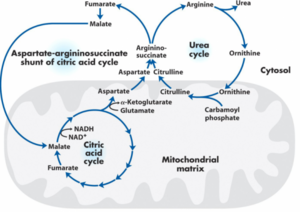12. Urea cycle and ammonium metabolism
Learning objectives
- Why must ammonium be excreted?
- How is ammonium excreted in humans?
- What are the sources of ammonium?
- Describe the urea cycle
- Which is the rate-limiting step of the urea cycle?
- How is the urea cycle regulated?
- What is the aspartate-argininosuccinate shunt?
Excretion of ammonium
Ammonium is toxic, especially to the brain, and so it should be excreted. In humans ammonium is excreted in the form of urea. Urea is water-soluble and non-toxic, at least at physiological levels.
The urea cycle occurs only in the liver, but its product, urea, is transported to the kidneys via the blood, from where it will be excreted.
Ammonium can originate from multiple sources
- Amino acid degradation
- Ammonium secretion from glutamine in kidney tubules
- Degradation of pyrimidine bases
- Production by intestinal bacteria
The process
The cycle begins with the synthesis of carbamoyl phosphate from ammonium and bicarbonate by carbamoyl phosphate synthetase 1 (CPS1). This is the rate-limiting step of the urea cycle, and also the point of regulation, as we’ll see below. Carbamoyl phosphate is then attached to ornithine by ornithine transcarbamoylase to yield citrulline. These two reactions occur in the mitochondria – the rest of the cycle occurs in the cytosol.
Citrulline + aspartate yields argininosuccinate. The enzyme argininosuccinase cleaves argininosuccinate into fumarate and arginine. Arginine loses one molecule of urea while becoming ornithine, which can start the cycle anew.
The cycle is energetically expensive. It consumes 4 ATP, but also produces 1 fumarate. This fumarate gives 1 NADH (= 2.5 ATP) in the citric acid cycle, so the net ATP use of the urea cycle becomes 4 – 2.5 = 1.5 ATP.
Regulation:
CPS1 is activated by N-acetylglutamate. This molecule is produced by N-acetylglutamate synthase, which produces it from acetyl-CoA and glutamate. When energy (acetyl-CoA) and amino acids (glutamate) are abundant, this enzyme is stimulated and will produce more N-acetylglutamate, thereby stimulating the urea cycle.
N-acetyl-glutamate synthase is also stimulated by arginine.
The aspartate-argininosuccinate shunt

As outlined above, one fumarate molecule is produced in the urea cycle. However, the urea cycle occurs in the cytosol, while the citric acid cycle occurs in the mitochondria. This fumarate needs to be transported into the mitochondria to be useful.
This is overcome by cytosolic fumarase, which converts the fumarate into malate. This malate can be transported into the mitochondria, where it enters the citric acid cycle to be converted into oxaloacetate, which yields 1 NADH (= 2.5 ATP). This oxaloacetate can be transaminated with glutamate to yield α-ketoglutarate and aspartate. This aspartate then goes into the urea cycle. This cycle is called the aspartate-argininosuccinate shunt.
Summary
- Why must ammonium be excreted?
- Because it is toxic, especially to the brain
- How is ammonium excreted in humans?
- By converting it to urea, which is excreted in urine
- What are the sources of ammonium?
- Amino acid degradation
- Ammonium secretion from glutamine in kidney tubules
- Degradation of pyrimidine bases
- Production by intestinal bacteria
- Describe the urea cycle
- Which is the rate-limiting step of the urea cycle?
- Carbamoyl phosphate synthetase 1
- How is the urea cycle regulated?
- CPS1 is stimulated directly by N-acetylglutamate
- N-acetylglutamate is produced in abundance of amino acids and in presence of arginine
- What is the aspartate-argininosuccinate shunt?
- The aspartate-argininosuccinate shunt connects the urea cycle and the TCA cycle, allowing the fumarate produced in the urea cycle to be utilized in the TCA cycle
